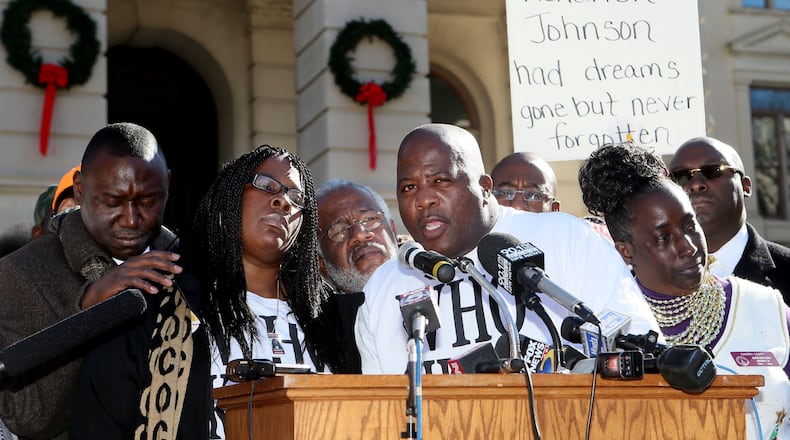It seems everyone here has made up his mind about what happened to Kendrick Johnson.
But, 150 miles up the road, indecision reigns.
It’s been 15 months since U.S. Attorney Michael Moore launched a federal probe into the death of Johnson, an athletic 17-year-old found dead in a wrapped-up gym mat, and the lack of a resolution has started to take its toll on this south Georgia town best known for its 28 state high school football championships
Lives have been threatened. Reputations have been tarnished. Dreams have been put on hold. Age-old divisions have been exacerbated.
Whether Moore chooses to uphold the conclusion by local and state law enforcement that Johnson's death was an accident, or pursues criminal charges, opinions about what happened Jan. 10, 2013 inside the old gymnasium at Lowndes High are unlikely to change. The more time that passes, the more polarized Valdosta becomes.
“The reality is that 20 years from now, the people who think KJ was murdered are still going to think that way,” said Chris Beckham, who hosts a popular radio talk show in Valdosta. “Same for the other side.”
Kenneth and Jackie Johnson have always believed their son met with foul play. It didn’t take long for them to point a finger at Brian Bell, who had gotten into a fight with Kendrick more than a year before his death.
Last November, The Atlanta Journal-Constitution reported that Bell and his older brother Branden had received notification from Moore, the U.S. attorney based in Macon, that they were targets of the grand jury's investigation into Johnson's death. Two months later, the Johnsons filed a wrongful death lawsuit alleging an unnamed female lured their son into the gym where he was fatally beaten by the brothers at the behest of their father.
Although neither the Bell boys or their father have been charged, many feel they’ve already been convicted.
Her family has been turned upside down by the allegations, said Karen Bell, with her youngest son Brian paying the biggest price.
“What should be one of the best time of his life has turned into a nightmare,” she said. Brian, 17, was encouraged by school officials to enroll in a work study program that takes him off-campus for half the school day. And just last week, Florida State University withdrew its scholarship offer to the once-prized recruit.
For many of Bell’s supporters, that was the final straw. In response, they organized a prayer vigil last Monday outside the Lowndes County Courthouse, where the federal grand jury investigating Johnson’s death continues to hear testimony from witnesses.
But unity won’t come so easy, as evidenced by the significant police presence at the event after online provocateurs threatened violence.
Michael Ross, a Lowndes High senior who was friends with Johnson, said he’s been called everything from a murderer to a racist simply for defending Bell.
“I get put in the middle of this because I stood by my friends,” said Ross, 18. “People who know Brian, black or white, know he didn’t do this. But with other people, there’s no two-way argument. Their minds are made up, so there’s no need to debate it. If you do, you get called names.”
Baily Peacock, a 17-year-old senior, said she and her friends have been “harassed and intimidated” for months by “cyberbullies” convinced that Johnson was murdered.
“Everyone’s ready for this to be over,” she said.
There are indications that Moore’s investigation is finally nearing its conclusion. But those who believe the official line, that Johnson died accidentally, say they are concerned the prosecutor is determined to file charges regardless of the evidence.
“He’s looked every under rock, and there’s nothing there,” Beckham said. “I blame him for a lot of what’s gone on.”
Moore has declined comment except to say the investigation “has proven more complicated” and taken longer than anticipated. But, according to Benjamin Crump, a lawyer for the Johnsons, the prosecutor told the family he is convinced Kendrick didn’t die accidentally.
“They’re investigating it as a homicide,” Crump told The Atlanta Journal-Constitution last month.
It’s unclear whether the Bell boys are still targets of the federal prosecutor.
Their alibis were confirmed by the Lowndes sheriff, and subsequent testimony placed Branden Bell on a school bus headed to a wrestling tournament in Macon at the time Johnson was last seen, while surveillance cameras showed Brian was in class, across campus.
The Johnsons’ suit also alleges a massive cover-up by the Lowndes sheriff, the GBI, the state medical examiner’s office and school officials.
“It’s just not logical,” Beckham said. “For all those people to be involved, and to keep that a secret for two years … I just don’t buy it.”
But to many, particularly those in Valdosta’s black community who have little faith in the police or justice system, an elaborate cover-up is not that far-fetched.
The ongoing federal probe is proof enough that foul play was involved in Johnson’s death, say those who buy into the cover-up.
“There were a lot of inconsistencies in how the investigation was first handled that still linger,” said Marcus Coleman, spokesman for the Johnsons. “The delay in contacting the coroner, the way Kendrick’s clothes were never found.”
Coleman also contends the Lowndes sheriff, Chris Prine, ruled Johnson’s death an accident before the autopsy was completed.
Whichever side people fall on it’s clear the investigation has aggravated old tensions.
“There’s a lot of people who want to believe there is a conspiracy,” said Angela Penn, a Valdosta evangelist and active member of the local branch of the Southern Christian Leadership Conference.
“It’s re-divided us on racial and class lines,” she said.
And it’s opened some new wounds, as well, casting Valdosta in a light closer to caricature than reality, say many who live here.
“W’ve been portrayed as backwards, racist and people are saying we’ve had enough,” Beckham said. “Valdosta has its scars, but we’re not anything like what’s been depicted.”
Clearly, Valdosta has come a long way from in the 97 years since a local African-American woman, Mary Turner, eight months pregnant at the time, was lynched after she publicly denounced the killing of her husband by a white mob. Turner, 33, was tied by her ankles, hung upside down from a tree alongside the Little River, doused in gasoline and set on fire, horrifying the nation and prompting a mass exodus of more than 500 black residents from the area.
Today, African-Americans make up more than 51 percent of Valdosta’s population, according to the 2010 U.S. Census, with whites accounting for approximately 41 percent.
But divisions remain.
“The pain and hurt of yesterday is still there,” said the Rev. Darren Neal, pastor of Greater St. Peter Methodist Church of Valdosta. “A lot of these problems have festered because we don’t know each other. We need to concentrate on healing this community.”
About the Author
The Latest
Featured



